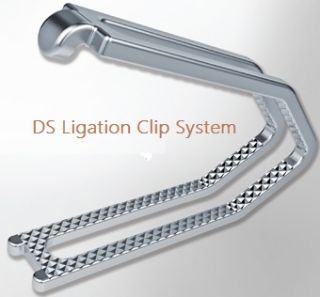The DS Ligation Clip System is Asculap latest advancement which provides significant cost savings in laparoscopic appendectomies without compromising on security if compared to Endo GI linear stapler. Pneumatically powered clip applier helps surgeon and gynecologidt save time and increase precision during laparoscopic procedures as well as reduce cost and waste over your current clip applier system.
Laparoscopic surgery has become a popular alternative to traditional open surgery due to its shorter recovery time, reduced pain, and lower risk of complications. One area where laparoscopic surgery has particularly shown its benefits is in appendectomy, the surgical removal of the appendix. Laparoscopic appendectomy has become the standard of care for uncomplicated appendicitis, and new laparoscopic ligation systems have further improved the procedure's safety and efficacy. In this essay, we will discuss the laparoscopic ligation system and its benefits during appendectomy.
Overview of Laparoscopic Appendectomy:
Laparoscopic appendectomy is a minimally invasive surgical procedure used to remove the appendix. The procedure involves the insertion of a small camera and surgical instruments through small incisions in the abdomen. Laparoscopic appendectomy has several advantages over traditional open surgery, including a shorter hospital stay, less postoperative pain, and a quicker recovery time.
Laparoscopic Ligation System:
The laparoscopic ligation system is a new technological advancement in the field of laparoscopic surgery that improves the safety and efficacy of laparoscopic appendectomy. The system uses a specialized device to ligate the appendix, reducing the risk of postoperative complications such as infection and bleeding.
Benefits of Laparoscopic Ligation System:
Reduced Blood Loss: The laparoscopic ligation system reduces blood loss during surgery, leading to a safer and more efficient procedure. This is especially important for patients with bleeding disorders or those who are at higher risk of postoperative bleeding.
Reduced Postoperative Pain: The use of the laparoscopic ligation system can also reduce postoperative pain by minimizing tissue trauma and reducing the need for additional suturing.
Reduced Infection Risk: The laparoscopic ligation system reduces the risk of infection by minimizing tissue trauma and reducing the need for additional suturing. This can lead to a quicker recovery time and lower healthcare costs.
Faster Recovery Time: The laparoscopic ligation system can lead to a faster recovery time by minimizing tissue trauma and reducing the need for additional suturing. This can lead to a shorter hospital stay and a quicker return to normal activities.
Cost-Effective: The use of the laparoscopic ligation system can be cost-effective. By reducing the risk of complications and the need for additional suturing, the system can help to avoid costly healthcare expenses associated with complications, such as extended hospital stays and additional surgical procedures.
Advancements in laparoscopic surgery have revolutionized the way surgeries are performed, providing patients with a less invasive and faster way to recover. Laparoscopic surgery has been found to have several advantages over traditional open surgery, including reduced pain, quicker recovery times, shorter hospital stays, and reduced risk of complications. As technology continues to advance, new laparoscopic tools and techniques are being developed, improving the safety and efficacy of laparoscopic surgery. In this essay, we will discuss some of the latest advancements in laparoscopic surgery.
Single-Incision Laparoscopic Surgery (SILS):
Single-Incision Laparoscopic Surgery (SILS) is a technique where surgery is performed through a single small incision. This technique reduces the number of incisions and the size of the scars, resulting in less postoperative pain and a faster recovery time. SILS can be used for a wide range of surgeries, including appendectomy, cholecystectomy, and hysterectomy.
Robotic-Assisted Laparoscopic Surgery:Robotic-assisted laparoscopic surgery is a minimally invasive surgical technique that utilizes robotic arms to perform surgery. The surgeon controls the robotic arms, which are equipped with surgical instruments and a high-resolution camera. Robotic surgery provides increased precision and flexibility, reducing the risk of complications and improving patient outcomes.
Laparoscopic Ultrasound:
Laparoscopic ultrasound is a technique where ultrasound imaging is used during laparoscopic surgery. The ultrasound probe is inserted through one of the laparoscopic ports, providing real-time images of the organs being operated on. Laparoscopic ultrasound can be used in surgeries such as liver resection and pancreatic surgery, providing surgeons with a more accurate view of the organs being operated on.
Laparoscopic 3D Imaging:Laparoscopic 3D imaging is a new technology that provides surgeons with a more realistic view of the surgical site during laparoscopic surgery. The technology uses a 3D camera and high-resolution monitors, allowing surgeons to view the surgical site in 3D, improving depth perception and reducing the risk of complications.
Advanced Energy Devices:Advanced energy devices, such as harmonic scalpels and argon beam coagulators, have improved the safety and efficacy of laparoscopic surgery. These devices use energy to seal blood vessels and tissue, reducing the risk of bleeding and postoperative complications.
Fluorescence-Guided Surgery:Fluorescence-guided surgery is a technique where a fluorescent dye is injected into the patient prior to surgery. During surgery, the dye is activated by a special light, allowing surgeons to visualize the organs being operated on. This technique can be used in surgeries such as liver resection and lymph node dissection, improving surgical precision and reducing the risk of complications.
Conclusion:
Advancements in laparoscopic surgery have revolutionized the way surgeries are performed, providing patients with a less invasive and faster way to recover. The advancements discussed in this essay, such as SILS, robotic-assisted laparoscopic surgery, laparoscopic ultrasound, laparoscopic 3D imaging, advanced energy devices, and fluorescence-guided surgery, have improved the safety and efficacy of laparoscopic surgery, reducing the risk of complications and improving patient outcomes. As technology continues to advance, we can expect to see even more improvements in laparoscopic surgery, leading to safer, more effective, and less invasive surgical procedures.






